NEW ORLEANS
August 29, 2013
STRANGER: Tom Fitzmorris
LOCATION: Tommy’s Cuisine, 746 Tchoupitoulas Street, New Orleans
THEME: Dinner with a restaurant critic
Tom Fitzmorris loves eating in restaurants.
That’s good given his career as a restaurant critic and host of a long-running radio show all about food. And even better that he lives in New Orleans, a city famed for its culinary prowess, and a place that Tom has lived his whole life — he was born there on Mardi Gras in 1951.
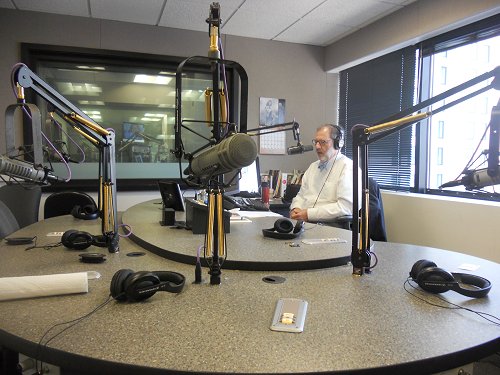
Tom was on air when we first met, during the second hour of his three-hour Food Show that broadcasts from a downtown office near Canal Street. He waved me in to his studio and I did my best to avoid making a noise as I watched him capably juggle anecdotes, advertisements, and calls on everything from boiling peanuts to who sells the best bagels in the city.
He seemed at ease in front of the microphone, sitting in a neat suit with a bright bow tie. When he stood up to greet me during a commercial break he beamed a welcoming smile, stretching out his arm for a strong handshake. He’s tall, a solidly built man with a disarming wit and energetic chain-of-consciousness manner of speaking that drags you willingly along for the ride.
“I love eating in restaurants, I really do,” he said after wrapping up his show and walking me toward upscale Italian restaurant Tommy’s. He’d picked the place after turning down my original suggestion of New Orleans landmark K-Paul’s because years ago he was banned from the place by owner Paul Prudhomme. It’s sometimes said that journalists aren’t succeeding at their job unless they’re making someone unhappy, so a restaurant critic could take ejection as a badge of honor.
Tom had shared that story by email even before we met for the first time. At dinner that night I’d hear a host of other remarkably upfront and honest stories, some good, some bad, probably being told for the umpteenth time but all of them recounted in a friendly manner making me feel like I was being let in on a secret. I wasn’t, many of the stories are in a recent book Tom wrote.
The book is Hungry Town — the title of which I shamelessly stole for this article — and it’s a breezy, informative read, as I learned from the free copy Tom gave me. It recounts his years as a writer and radio host, and his development into a gourmet who loves good food.
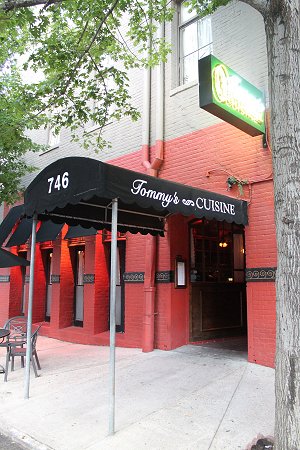
Although I tore through the book on the flight back to Washington, D.C., I didn’t have to wait to learn Tom’s story, because that Thursday night in New Orleans he was ready to tell me over a lavish meal at Tommy’s.
The service was flawless from entry to exit, and it’s clear Tom is a known face around these parts. He was greeted like an old friend by a parade of waiters, who reminisced about serving the critic at other, now-defunct restaurants around town. And then we met restaurant owner Tommy Andrade, a softly-spoken but commanding presence, who won me over instantly by suggesting we start off with a glass of 1990 Barolo wine. It was delicious, even though I admitted to Tom I know little about wine.
He waved that comment off with a chuckle. “People tell me all the time that they don’t know anything about wine, I say there’s only thing you need to know, it’s how to do this,” and then he gulped down his glass, smiling afterward. “You’ll know a good one, you’ll know a bad one. And that’s a good one. Barolo is one of the best wines made in Italy.”
Mr. Andrade didn’t even let us see menus that night, instead promising to craft a personalized menu of several dishes, starting with a crisp, surprisingly light bruschetta to snack on while sipping on the wine.
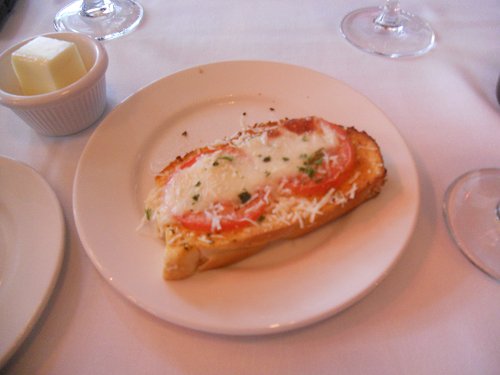
With his sharp suit, seemingly endless knowledge of food and wine, and good humor, Mr. Andrade and his attention to detail pushed the evening into a new level of class.
“He’s the old pro,” Tom said about the owner after he left us to our wine and awaiting the first course. I took a second to appreciate the refined look of the place: clean white tablecloths, unobtrusive lighting, wood paneling, and framed photos of friends and customers lining a far wall. “This is my kind of restaurant. Not the look so much, I don’t care about looks, I’m a food guy. And I would eat here every week if I didn’t have the job I have,” Tom said.
That job primarily is the host of the radio show, which he does weekdays, for three hours at a time. He also writes extensively — 5,000 words a day at least — for his website, The New Orleans Menu, which includes restaurant reviews, lists of best restaurants of all types, and a running tab of restaurants currently open in the city, a project he started in the aftermath of Hurricane Katrina.
Tom told me that I had arrived in the city on the eighth anniversary of the storm. Back in 2005 when the storm hit, the number of restaurants open in the city plummeted from 800-plus to zero. Tom and his family had evacuated, and he’s able to broadcast his show remotely, so when he returned to air days later callers started to ask him which restaurants around town had reopened. His initial response: you’re out of your mind, the city was officially closed. “But the question kept coming.”
So he researched and found 20 or so restaurants open on the north shore outside of the city, and started to keep a running list on his website. He kept adding to it and is still adding to it, and said the numbers show a city whose culinary options have not only recovered but exceeded what they were before the hurricane. From 809 “real” restaurants open before the storm — Tom doesn’t count fast food places — the number had jumped to 1,357 as of August 29.
Plenty of new options for Tom to explore as a restaurant critic, something he’s been writing or talking about since the early 1970s. His interest in food stems back to his childhood, when his mother would cook classic country French Creole meals: gumbo, red beans and rice, and the like. “We ate well, but we ate simply. But I’ve always liked good food.”
The switch that flipped and turned him on to critiquing food happened in 1970, thanks to University of New Orleans Professor Richard Collin, who had just written a book called the New Orleans Underground Gourmet — the first ever rated restaurant guide for the city. Though people would often sing the praises of the Big Easy’s cuisine, no-one had approached it from a comprehensive, critical point of view. “And Richard Collin did. I remember reading it and thinking, ‘My god, I had no idea that that world was out there,’” Tom said.
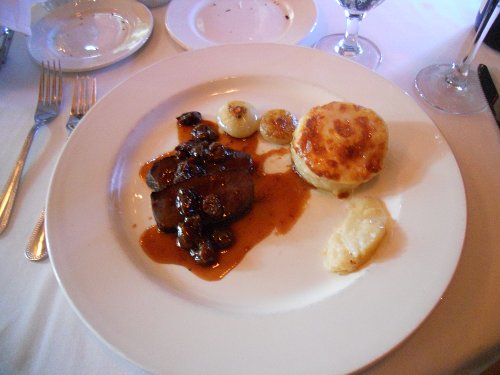
That world today should include the venison special that Mr. Andrade ordered for us, with a sweet, cherry-based Montmorency sauce pairing well with the tender meat. Looked great, tasted great, and smelled great. It was a tremendous starter to get our appetites revving, and Tom was full of praise for the dish, often sidetracking from conversation to throw it another compliment.
He’s always been ready with a thesaurus’ worth of words to describe dishes, dating back to his first attempt at restaurant reviews: a weekly column launched in September 1972 for the University of New Orleans’ campus newsletter, which he said was inspired by Collin’s book. “In the early days when I would eat, my mind would be practically boiling over with what I was going to say about it, it was a huge thrill, I couldn’t wait to get it down,” Tom said.
His way with words also helps on the radio, an industry he wanted to work in even more than writing or critiquing restaurants. At age 8, Tom told his father he wanted to be a disc jockey, to which Mr. Fitzmorris rebutted that only playboys were DJs. “The way I registered that was: step one, become a playboy. And I saw being a restaurant critic as a stepping stone to getting on the radio,” Tom said.
But getting there took some time, via a diversion through a few years largely focused on print media due to the difficulty involved with getting a break on the airwaves.
“On the print side of things, everything I did turned to gold. I found it easy to sell print pieces,” Tom said, with his repertoire covering restaurant reviews, feature articles, movie reviews, and more. His initial efforts on the campus newsletter were just the beginning. At 23, he was offered the editor-in-chief role at New Orleans Magazine by the owner, who liked Tom’s writing.
Tom said he was in over his head but threw himself into the position, noting, “One of the first things you learn in this business is the answer is always yes.”
Despite an ever-growing trade in writing, Tom kept pursuing his goal of working in radio. He approached a local station and asked to be part of a regular feature in which people from other media would come in and give a two-minute commentary. “They said, ‘You wouldn’t happen to be a liberal would you?’ I said yes. They told me, ‘Good, we need one to balance things up.”

So his career on the airwaves was born. After about six months, things were going well so Tom pitched a daily feature on restaurants. His bosses didn’t want to commit that much time to dining out, so for several years he did a two-minute show talking about restaurants. That progressed into a weekend shift, mixing talk and music, and his radio experience grew.
Eventually the woman who would eventually become his wife called him, saying radio station WSMB was undergoing a revamp and wanted Tom to do a daily food show. By this point his stint at New Orleans Magazine was over and he was freelancing, so he accepted the full-time commitment. Tom had realized his goal of being a disc jockey, and even better he got to dedicate his time on air to talking exclusively about cooking and restaurants.
Another perk: the wife he gained out of the process, Mary Ann. They have two children, one is a sculptor, the other works in the movie industry in Los Angeles. Tom spoke with obvious affection for all of them, including some light jesting about his initial run-in with his future spouse.
Mary Ann — who was responsible for hiring Tom for the job at the radio station that would become the Food Show — wasn’t won over with him initially, to say the least. “When we were working out the details of my show, she said, ‘I’ve got to tell you something. Personally, I think you’re an asshole.’ And then six months later we were married,” Tom said, erupting in a hearty laugh.
Tom said he wasn’t sure why his future wife (who clearly overcome her initial reservations) thought he resembled a part of the human posterior, but he said others sometimes get that impression from him. “Some chefs certainly think so,” he conceded, referencing the time Paul Prudhomme banned him from K-Paul’s. Tom is still not exactly sure what prompted that decision, though Prudhomme at the time chastised the critic for — in the chef’s opinion — not knowing anything about food.

Another prominent figure in New Orleans’ restaurant industry also gave Tom a similar, but far more polite, dressing down over his supposed lack of culinary knowledge.
Dick Brennan Sr., one of the owners of landmark Garden District restaurant Commander’s Palace, saw Tom having lunch there one day. He sat down with Tom and, after a lavish meal and copious amounts of alcohol, leaned in close and with a thick Irish accent punctuated by a stutter said, “Tom, I gotta tell you something: You don’t know nothing about food.”
Brennan offered to loan Tom $5,000 to travel to France and learn cuisine. Tom never took the offer, but saw it as a wake-up call to learn more about cooking. “I had the gall when I was young to think I knew everything I needed to know, if I thought something tasted good, that made it good, and if it tasted bad, it was bad. And that’s not true,” Tom said.
He undertook several projects that he believes are responsible for a “quadrupling” of his food knowledge and have helped him finesse his criticisms. One of those efforts was working with a chief on a large Italian cookbook. For six months Tom was in a kitchen with the chef, watching the craft of cooking, learning a host of new flavors and techniques.
Around the same time he was also doing a short feature on television news going to a different restaurant each week to see a chef cook a particular recipe. Seeing all that preparation up close and standing alongside the chefs helped Tom expand his knowledge. He eventually developed his skills enough to write his own cookbook, which met with a welcome reaction. “I knew that if I got away with that, then I’ve actually gotten somewhere,” Tom said, flashing another smile.
So Tom can use the Food Show to tout his knowledge and also preach on the topics he’s invested in: the craft of cooking, trying new food, and the experience of dining out.
He’s sad to see dressing for dinner fading away as a general concept, so I hope I didn’t disappoint by showing up in an un-tucked button-down shirt. I’m a fan of the white tablecloth dinner that Tom is fond of, so Tommy’s proved to be ideal for the both of us. Particularly as the tasty dishes kept coming out, with a crab ravigote to follow the venison appetizer.
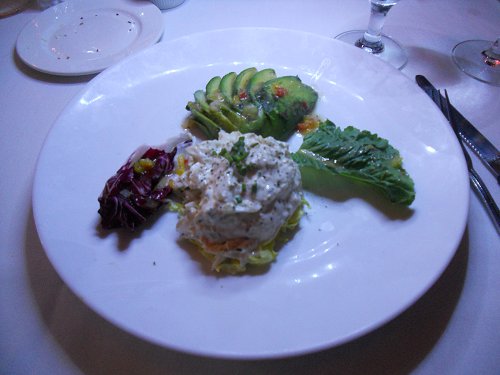
Hearty crabmeat was presented in a sauce consisting of mayonnaise, lemon juice, capers, onions, and a few other flavors that I don’t have the skill to distinguish.
Tom said it’s one of the most popular appetizers in New Orleans. As we tucked in to the food — the crabmeat suitably lumpy and fresh, the sauce on the thicker side — Tom told me we were eating a well-made version, though his preference is for a lighter sauce.
Maybe the Barolo helped loosen our tongues, but sharing this meal with Tom was an incredibly relaxing experience, like dining with an old friend. In-between each course we’d veer off topic to discuss everything from journalism to politics and more. Tom’s outgoing nature must be a boon for the radio show, and also for a regular adjunct to the show called Eat Club, an event he organizes which takes dozens of people to a restaurant for a sampling menu paired with wines.
The Eat Club dinners stemmed largely from Tom noticing he couldn’t eat in the quantities he used to at restaurants. So he thought about taking a bunch of listeners to dinner and instead of having to keep ordering whole portions and make repeat trips to a restaurant, he could sample several dishes in one night — all while moving from table to table to mingle with listeners, share anecdotes and generally make sure everyone is having a good time. It’s been going strong for 20 years, Tom said, adding, “If I’m remembered for anything I think it’ll be for that.”
Dining with Tom, I got a hint of what it must be like for the Eat Club attendees. He’s affable, interesting and highly knowledgeable on the subject of food. When our soft shell crab entree arrived, he not only explained the dish to me — it was the first time I’d had it, and I was unsure whether everything is edible (it is) — but also told me the story of the “shedders” that work full-time catching the crabs at just the right moment they shed their old shells, and the history of the dish.
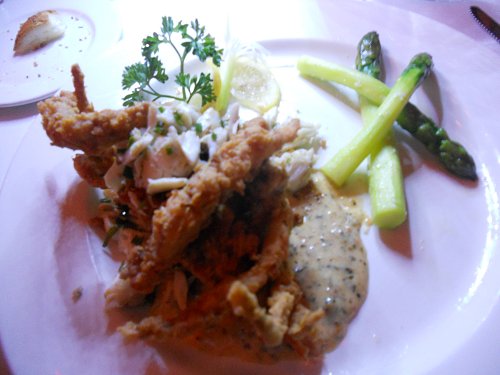
First time was a charm because, despite my general preference against seafood, I was won over in seconds after biting into the crunchy, rich batter and the thick crabmeat within.
“This is one of the great delicacies of New Orleans,” Tom said, as we both took photos of the food. “They call this a whale because of the size of it,” he said, as conversation went into a brief respite so that we could savor the crab, served with some fresh asparagus and a slice of lemon.
To my relatively novice taste buds it was a flawless meal, and I’m glad Mr. Andrade and Tom pushed me into trying food I’d have shied away from if I were choosing. And it turns out at least one of the dishes, the crabmeat ravigote, would be on Tom’s dream menu.
“My thinking about it is largely about contrasts and local-ism,” he said when I quizzed him on his ideal dinner. “I love New Orleans food. It’s my favorite.”
So his fantasy night at a restaurant would consist of several smaller courses, including the ravigote followed by baked oysters on the half shell with different sauces. He’d follow that with some turtle soup, then a confit of duck leg, then a filet of some type of fish, followed by a lamb or veal chop and then some quail or Cornish hen, ending with cheese.
I think I got gout just listening to it.
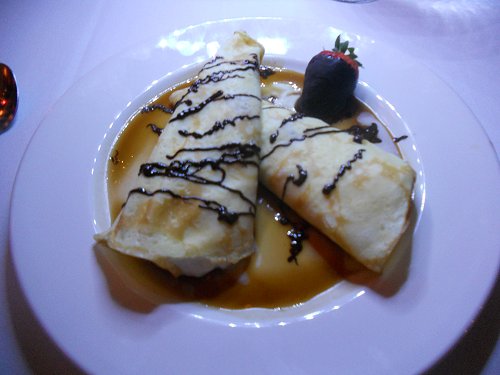
What was missing from the dream menu was dessert — but Mr. Andrade was back to describe the last dish of the night, two crepes stuffed with Chantilly cream and strawberries sitting in a cognac-based sauce, with chocolate drizzled over them. Light, fresh, sweet, it was the perfect end to the meal.
As we sipped on coffee after the crepes, Tom told me he sees a bright future ahead for his show. And it’s a full-time job from the time he wakes until he goes to sleep. “My profession takes up all my time and I’m happy about it.” Based off my experiences in the last few years dining around New Orleans, he’s in the right city for his line of work.
Food has always, and will always be, a major topic in New Orleans, he said. “This is a passionate subject around here, you get people going on food, they don’t stop.”
In Hungry Town, Tom describes his belief that the strong restaurant culture in the city is in part to credit for New Orleans’ recovery after Hurricane Katrina. He sees the vibrancy of the ever-growing food sector as a sign that he’ll have plenty to cover for years to come.
Tom told me he’s the only member of his immediate family that never gives any thought to moving elsewhere, because it’s the best place for his job. “In New Orleans we love to eat. And I’m doing exactly what I always wanted to do, and there’s no end in sight. I think I’ll be able to do this for the rest of my life and I love it. I never get tired of it.”
Tom Fitzmorris’ book Hungry Town and cookbook Tom Fitzmorris’ New Orleans Food are available through his website The New Orleans Menu.
The site also has more information on his Food Show radio broadcast, including links to a live stream of his daily show and archives of past shows.
whbec7
wbi32l
hil88q